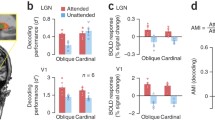Summary
Microelectrode penetrations nearly normal to the layers of foveal striate cortex in awake, behaving monkeys reveal a shift in orientation preference between cells in the upper and lower layers. Mean shift size for 57 penetrations is 54.8 °, with 70% of the penetrations showing shifts of 45–90 °. Marking lesions localize the shift to the border between layers 4C and 5. The data are suggestive of inhibition between the upper and lower layers within an “orientation column”.
Similar content being viewed by others
References
Albus K (1975) A quantitative study of the projection area of the central and the paracentral visual field in area 17 of the cat. Exp Brain Res 24: 181–202
Bauer R, Dow BM, Vautin RG (1980) Laminar distribution of preferred orientations in foveal striate cortex of monkey. Exp Brain Res 41: 54–60
Benevento LA, Creutzfeldt OD, Kuhnt V (1972) Significance of intracortical inhibition in the visual cortex. Nature 238: 124–126
Braitenberg V, Braitenberg C (1979) Geometry of orientation columns in the visual cortex. Biol Cybern 33: 179–186
Brodmann K (1905) Beitrage zur histologischen Localisation der Gro\hirnrinde. Dritte Mitteilung: Die Rinderfelder der niederen Affen. J Physiol Neurol (Leipz) 4: 177–226
Dow BM (1974) Functional classes of cells and their laminar distribution in monkey visual cortex. J Neurophysiol 37: 927–946
Dow BM, Snyder AZ, Vautin RG, Bauer R (1981) Magnification factor and receptive field size in foveal striate cortex of the monkey. Exp Brain Res 44: 213–228
Evarts EV (1966) Methods for recording activity of individual neurons in moving animals. In: Rushmer RF (ed) Methods in medical research, vol 11. Year Book, Chicago, pp 241–250
Horton JC, Hubel DH (1981) Regular patchy distribution of cytochrome oxidase staining in primary visual cortex of macaque monkey. Nature 292: 762–764
Hubel DH, Wiesel TN (1962) Receptive fields, binocular interaction and functional architecture in the cat's visual cortex. J Physiol (Lond) 160: 106–154
Hubel DH, Wiesel TN (1968) Receptive fields and functional architecture of monkey striate cortex. J Physiol (Lond) 195: 215–243
Hubel DH, Wiesel TN (1974) Sequence regularity and geometry of orientation columns in the monkey striate cortex. J Comp Neurol 158: 267–294
Hubel DH, Wiesel TN, Stryker MP (1978) Anatomical demonstration of orientation columns in macaque monkey. J Comp Neurol 177: 361–380
Hubel DH, Livingstone MS (1981) Regions of poor orientation tuning coincide with patches of cytochrome oxidase staining in monkey striate cortex. Neuroscience Abstr 7: 357
Humphrey AL, Hendrickson AE (1980) Radial zones of high metabolic activity in squirrel monkey. Neuroscience Abstr 6: 315
LeVay S (1973) Synaptic patterns in the visual cortex of the cat and monkey. Electron microscopy of Golgi preparations. J Comp Neurol 150: 53–86
Livingstone MS, Hubel DH (1981) Effects of sleep and arousal on the processing of visual information in the cat. Nature 291: 554–561.
Protter MH, Morrey CG Jr (1964) Modern mathematical analysis, chapt 4. Addison-Wesley, Reading, MA
Ribak CE (1978) Aspinous and sparsely-spinous stellate neurons in the visual cortex of rats contain glutamic acid decarboxylase. J Neurocytol 7: 461–478
Sillito AM (1975) The contribution of inhibitory mechanisms to the receptive field properties of neurones in the striate cortex of the cat. J Physiol (Lond) 250: 305–329
Sillito AM, Kemp JA, Milson JA, Berardi N (1980) A reevaluation of the mechanisms underlying simple cell orientation selectivity. Brain Res 194: 517–520
Somogyi P, Cowey A (1981) Combined Golgi and electron microscopic study on the synapses formed by double bouquet cells in the visual cortex of the cat and monkey. J Comp Neurol 195: 547–566
Somogyi P, Cowey A, Halasz N, Freund TF (1981) Vertical organization of neurones accumulated 3H-GABA in visual cortex of rhesus monkey. Nature 294: 761–763
Tsumoto T, Eckart W, Creutzfeldt OD (1979) Modification of orientation sensitivity of cat visual cortex neurons by removal of GABA-mediated inhibition. Exp Brain Res 34: 351–363
Wurtz RH (1969) Visual receptive fields of striate cortex neurons in awake monkeys. J Neurophysiol 32: 727–742
Author information
Authors and Affiliations
Additional information
Supported by NIH grants EY02349 and 5-T32EY07019. R. Bauer was supported in part by a fellowship from the Deutsche Forschungsgemeinschaft (DFG)
Rights and permissions
About this article
Cite this article
Bauer, R., Dow, B.M., Snyder, A.Z. et al. Orientation shift between upper and lower layers in monkey visual cortex. Exp Brain Res 50, 133–145 (1983). https://doi.org/10.1007/BF00238240
Received:
Revised:
Issue Date:
DOI: https://doi.org/10.1007/BF00238240




